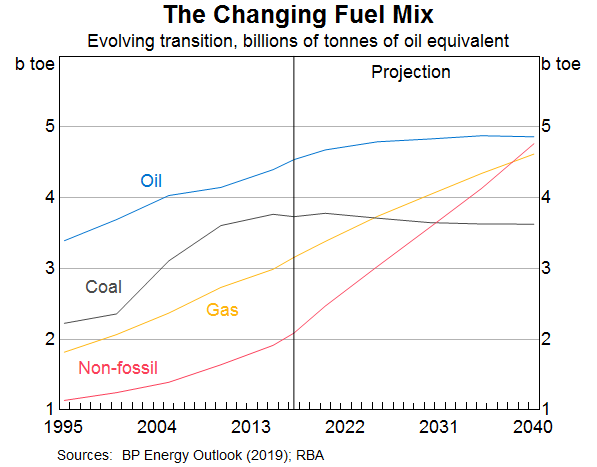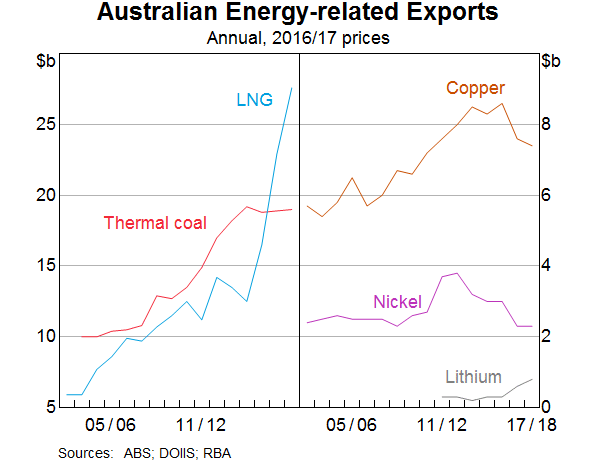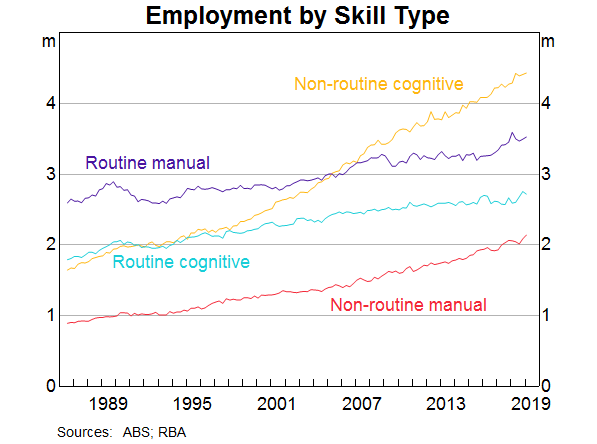Alexandra Heath, Head of Economic Analysis addresses the Association of Mining and Exploration Companies
Perth – 5 June 2019 Excerpt:
Global demand for Australia's commodities:
One of the biggest factors affecting the global demand for commodities is population growth – more people need more places to live, more food to eat and demand more energy. The process of industrialisation and urbanisation also increases demand for commodities, although the composition of that demand can change as countries become richer. For example, diets become increasingly protein-based and construction becomes more steel-intensive. The increase in demand from these factors will be offset to some extent over time by technological progress that allows commodity inputs to be used more efficiently. There are also policy considerations, such as governments' commitments to the Paris Agreement, that will affect the composition of commodity demand going forward.
...the global energy mix is expected to change significantly. For Australia, the projected changes in the global energy mix present both challenges and opportunities.
Under an assumption that things evolve with current policies in place, BP projects that coal demand will be reasonably stable in its 2019 BP Energy Outlook. Given the overall increase in energy demand, this implies coal's share of total energy consumption is expected to decline. At the same time, BP projects that there will be a significant increase in demand for non-fossil fuels partly driven by the falling cost of renewable energy generation enabled by technological change.[3] As this transition occurs, demand for natural gas is also expected to increase.

Thermal coal is one of Australia's largest energy-related exports. Together Japan, China and South Korea account for around 75 per cent of Australia's thermal coal exports and in all three countries there are plans to shift towards cleaner energy sources. One of those cleaner energy sources is LNG, which has become an increasingly important energy export for Australia. There is at least one large expansionary LNG project currently under assessment in Western Australia in anticipation of further strong increases in global demand for LNG.

There is also expected to be stronger demand for a range of metals that are inputs into batteries (especially lithium) and are used intensively in renewable generation and in electric vehicles (such as copper). No doubt those in the room are well aware of the opportunities for Australia in this space. A number of new lithium mines have been constructed in Western Australia in recent years and projects are increasingly looking to value-add through further downstream processing.
How do we weigh up the challenges and opportunities raised by changes to the global energy mix? One way is to think about scenarios. By its nature, scenario analysis relies on assumptions that can be debated, but it does provide the starting point for a conversation about the risks to be managed and the opportunities to prepare for.
The projections for energy demand I used earlier are BP's based on current policies. BP also produce a scenario in their report about how energy demand could change in a world where policies are broadly consistent with achieving governments' commitments to the climate goals set out in the Paris Agreement. Under this scenario, there is a faster global transition away from carbon-emitting sources of energy, and Australia's thermal coal exports would be expected to decline. Because this transition is projected to be relatively gradual, the effect on annual GDP growth would be relatively small, especially if the offsetting effects of increased demand for LNG or inputs into renewable energy generation are taken into account.
But it is important to recognise that the negative consequences of such a transition will be focused on specific geographic areas and communities that are unlikely to be the same ones reaping the benefits. This can be particularly challenging if there are limited opportunities to find alternative employment, which is often the case for coal-mining areas. The question is then what can be done to improve the ability of local communities to manage these challenges? There are also questions about what can be done to improve the ability of the economy as a whole and society more generally to manage the challenges associated with structural change and, perhaps more importantly, to leverage the opportunities associated with that change.
These are big questions, but they are not new questions.
Australia has experienced many structural changes where the effects on local communities have been much greater than the effects on the economy as a whole. At the same time a lot has been done over the past 50 years to improve the ability of the economy to adapt to structural change. For example, comparing the experience of the most recent mining investment boom with previous mining investment booms shows us that moving to a freely floating exchange rate significantly improved the economy's adjustment to huge increases in export prices.
A more adaptable workforce
The labour market is a key part of how the economy adjusts to structural change and how local communities are affected. The ability of individuals to adapt to changes in demand for skills is another important element of this adjustment.
To understand how the labour market has been changing over time, it is useful to classify jobs by whether they are routine or not and whether they mainly use manual skills or cognitive skills. You can see from this graph that in Australia there has been less growth in the number of routine jobs, which by their nature are relatively straightforward to automate. This process of automation requires investment in new technology that comes from innovation of various kinds including research and development. Innovation and technological change are important sources of productivity growth that underpin our economic prosperity over the longer term.

The most significant growth has been in non-routine jobs, particularly non-routine cognitive jobs. Non-routine jobs have features, such as interacting with people, or diagnosing and solving irregular problems, that are harder to automate.
These forces that have been apparent in the labour market as a whole are also present in the mining industry. For example, iron ore producers have begun to use autonomous haulage, which replaces multiple truck drivers with a single controller. Unlike a truck driver, a controller must be highly computer literate and be able to solve different problems. Autonomous trucks also require communications technology that must be maintained, which increases the demand for highly skilled communications technicians. Looking slightly deeper into the crystal ball, changes in the demand for different types of skills are likely to continue as electric mining equipment and vehicles become more commonplace, and robots replace human miners, especially in more dangerous environments.
These examples suggest that mining is going to become increasingly reliant on people with IT skills of various kinds. IT security specialists will be required to ensure autonomous systems are safe from outside interference, while software engineers and data scientists will be required to optimise real-time operations.
There is clearly a change in the nature of work and the skills required. It is important to emphasise, however, that it does not follow that fewer people will be employed overall. This is especially true when you take into account that some of the demand for new skills will be met by specialised service providers in other firms and other industries. Indeed, this outsourcing of specialised services as technological progress changes the nature of work is yet another broad trend in the labour market and the way business is done.
But how are we, as a country, going to equip people with these skills? Or, more specifically, how are firms in the resource sector going to do so? The easy answer is through education and training. But what does that mean? And is that any different to what we've already been doing?
The education sector will continue to have a role in making sure that future employees have work-ready skills. This will include teaching subject matter expertise, such as data analytics, robotics engineering and machine fitting, as well as more general skills such as digital literacy, the ability to work in teams with diverse skill sets and analytical thinking. The tertiary education sector will also continue to play a role in providing the research that underpins technological change. There are a lot of opportunities for business and the education sector to work together in this area.
Retraining of current employees should also be able to meet some of the demand for new skills. Traditionally, this might have been done on-the-job, but increasingly firms are looking to work with the education sector to achieve this retraining. For example, some mining companies have begun partnering with education providers to create courses to meet their changing employment needs, especially around automation. This change in emphasis towards life-long learning is another area where there are huge opportunities.
Conclusion
The purpose of this conference is to think about what the future holds for the resource sector. While predicting the future is difficult, understanding existing trends and running scenarios can be useful to test assumptions, and highlight challenges and opportunities.
The industrialisation and urbanisation of large emerging economies will continue to boost demand for commodities. Governments' commitments to significantly reduce carbon emissions are likely to benefit some parts of the resource sector, but provide challenges for others. At the same time, the economy will be constantly responding to the effects of technological change. History shows that it is important to have a policy environment and institutions that allow the economy to adapt to change. A system where businesses and the education sector work together to ensure people are equipped to adapt to the changing demand for skills is particularly important. There is a clear role for policy and a change in emphasis towards life-long learning to improve outcomes in this space.